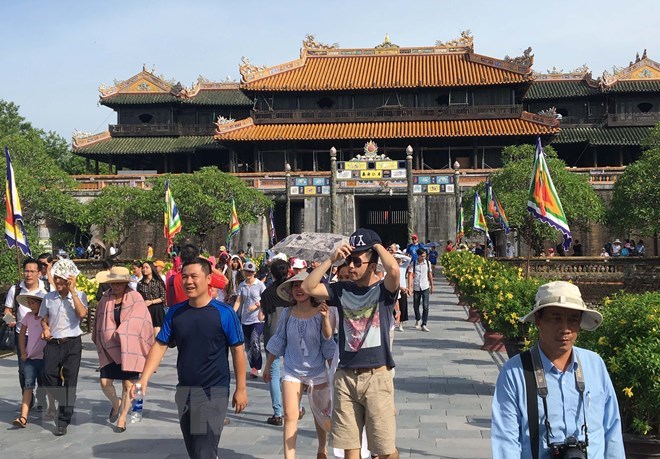
The Hue ancient citadel relic complex – a UNESCO World Cultural Heritage site – will be open with free admission for domestic visitors during the first three days of the 2019 Lunar New Year (February 5-7).
![]()

At Hue
ancient citadel relic complex (Source: VNA)
Holidaymakers
to the Hue ancient capital city on those days will have a chance to participate
in royal games and enjoy calligraphy and martial arts performances, along with
traditional dragon and lion dances.
As part of activities welcoming the arrival of Tet, the biggest and most
important festival year-round in Vietnam, the Hue Monuments Conservation Centre
will re-enact the Neu tree planting ceremony, a traditional ritual practised
under the Nguyen Dynasty (1802-1945) on January 28 (the 23rd day of the last
lunar month).
There will also be an array of activities such as wrapping chung cake (a
traditional Tet novelty cake made from glutinous rice).
In 2018, the Hue Monuments Conservation Centre earned 381.7 billion VND (16.4
million USD) from serving over 3.5 million tourists, up 19 percent compared to
the target set.
The centre has implemented 24 restoration projects with total investment
exceeding 278.8 billion VND (11.9 million USD).
Hue, the formal imperial capital of Vietnam for hundreds of years, is home to
five heritages recognised by UNESCO, including the ancient citadel relic
complex (a World Cultural Heritage site), Hue royal court music (an intangible
cultural heritage item), Nguyen Dynasty’s wood blocks (a documentary heritage
item), Nguyen Dynasty’s royal administrative documents (part of the
Asia-Pacific Register of UNESCO’s Memory of the World Programme), and
literature on Hue royal architecture (another documentary heritage).
The Hue imperial citadel relic site has been ranked second among the top seven
tourist attractions of Vietnam in 2017.
Source: VNA
A diverse chain of eco-tourism and resort destinations concentrated in Hoa Binh city and the districts of Tan Lac, Da Bac, and Luong Son… Along with the launch of several key high-quality resort tourism projects, these developments have reshaped the landscape and enhanced the appeal of Hoa Binh as a travel destination.
Boasting diverse terrain, a mild climate, and rich natural resources, Cao Phong district is increasingly asserting its place on Vietnam’s tourism map, attracting both domestic and foreign visitors. The district is renowned for its stunning landscapes, majestic mountains, a crystal-clear hydropower lake, and the unique cultural identity of local ethnic groups.
With its pristine landscapes, unique cultural heritage of Muong ethnic minority, and an expanding range of visitor experiences, Tan Lac district of Hoa Binh has fast become a captivating destination for both domestic and international tourists.
Until now, Sung village in Cao Son commune, Da Bac district remains the only Dao ethnic community in Hoa Binh province to develop a community-based tourism model. Beyond its untouched natural landscapes, cultural identity serves as the cornerstone attraction for visitors.
Alongside the diverse cultural identities of the Kinh, Muong, Tay, Thai, Dao, and Mong ethnic people, Hoa Binh province is also renowned as the "capital" of the northwestern Vietnamese cuisine, offering unique and distinctive dishes. At festivals, during Lunar New Year (Tet), or on significant family or community occasions, special dishes are prepared, leaving a lasting impression on visitors.
A Phong Linh (Yellow Tabebuia) flower garden in Thang village, Thach Yen commune, Cao Phong district is currently in full bloom, drawing a large number of visitors.



